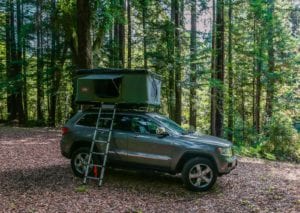The reason for writing for this roof top tent comparison is two-fold:
Firstly, the 2019 Roofnest Eagle model is available in the US (while the old model with a discounted price is still available. Secondly, Tepui have come out with the HyBox roof top cargo tent. Thanks to its hard-shell case and removable canopy Tepui’s roof tent has dual purpose: it can be used as a cargo box as well.
A Unique Feature…Or Not…
Before jumping right into the detailed features of both, a few thoughts on the new Tepui cargo tent. Tepui very cleverly built their marketing strategy around the fact that the canopy is attached to the hard shell by zippers, therefore the canopy is easily removable. The empty shell is ideal to chuck your stuff in it, so why not use it for storage, right?
But I thought, hang on a second, wasn’t the Tepui Lightning sold as cargo box too? And doesn’t the new Roofnest Sparrow have zippers all around too? A quick check on the website and there you go: all the new Roofnest models – the Sparrow and the Eagle – have removable canopies!
So, is it just clever marketing? Maybe not just that…Although Tepui did not re-invent the wheel, in all fairness, the HyBox does seem to hit two birds with one bullet.
Tepui Hybox v Roofnest Eagle 2019
First Glance
This is not going to be a major surprise, all look pretty similar. You have a choice of black or white color hard shell for all three models, the HyBox comes with a different color canvas: white shell with grey canopy and black shell with green canopy. They all look aerodynamic, slim and solid, I could not tell the difference if I did not see the logo on the side. The build quality is robust, you cannot really fault the materials used.
About Roofnest tents
Roofnest was founded by an Alaskan guy called Tim Nickles. He lives now in Colorado and that’s where Roofnest are based. The idea of Roofnest came from camping with friends and Tim’s obsession with gear and camping tech, adventures and exploration. Roofnest are a fairly new company (I could not find any info about the year it was founded), and their products have not been reviewed widely. (Although there are some reviews here, but be careful some of them were written by Tim Nickles). Roofnest are aiming to make the roof top experience available to as many people as possible. They structured their company to keep their overhead costs low and sell Roofnests directly to the customer, so they can keep their prices low.
About Tepui
Tepui are based out of Santa Cruz, California; an outdoor adventure company that offers high quality roof top camping tents since 2010. You may have heard that Tepui are not a family-owned company anymore, in December 2018 Thule bought Tepui. The management remained the same, so the enthusiasm is still there. The acquisition may enhance the seamless securing of the Tepui tents onto Thule crossbars. Tepui are well-known for their soft-shell canvas roof top tents, but their product line has lacked a decent hard-shell model. Until now.
Exteriors
Size
The Roofnest Eagle is 55″ wide, 85″ long and 11.5″ tall when closed, this makes the Eagle the largest member of the Roofnest family. The 11.5” height is an extremely low profile even amongst the streamlined hard shell roof top tents. No surprise, the HyBox is a bit higher when closed (12 ¾”) but the footprint is almost identical: 55″ x 84″.
Depending on your preferences you may not mind the higher profile, after all the Tepui Hybox must function as a cargo box too. Despite being taller than the Roofnest Eagle, it is not excessively high to adversely affect the balance of your car (unless you load it…), or to make the wind drag unbearable. On the other hand, it maximises the cargo capacity. If you do need the storage space, you will have to compromise a bit on the mpg and wind noise during travel, though.

Roofnest Eagle (above) has the slimmest profile on the market
Mystery #1 – Weight
The Tepui HyBox is significantly heavier, weighing 155 lbs without ladder, and 175 lbs with it. The Eagle is only 140 lbs, including the ladder. It also means that while the Eagle can be fitted on most cars (ie. larger estates), as long as you can fit the crossbars on your vehicle far enough from each other. The HyBox needs a big boy that has more than the standard 165lbs roof loading capacity.
It would be nice to know where the extra weight of the HyBox comes from, it may be the base plate or the fibre-glass shell? Both have the same specs: ABS fibreglass shell, inner insulation, aluminium plates, gas struts, same size. The HyBox has slightly thinner canvas, so it is mystery #1.
Mystery #2 – Loading Capacity
What I cannot quite grasp is that why Tepui keeps the loading capacity of the cargo box a secret? It is heavy, fair enough. You unzip the canopy, remove the mattress and it becomes slightly lighter but how much can you load into it then? You get 23 cubic feet storage capacity, but it sure matters whether it is 23 cubic feet of spare clothing, bags of cement or half a pig?
If Tepui build their marketing campaign around the HyBox being a cargo box, why not disclose the specifics?

Tepui HyBox cargo tent
Mounting
Mounting the Eagle on top of your vehicle is relatively easy. Although it is lighter than the HyBox you need two people to place it on the crossbars. Do check the distance of you crossbars as you need them at least 33” apart but the preferred distance is 38”!
Tepui did not specify the minimum requirements for fitting the HyBox onto your vehicle.
Fabrics
As mentioned, the HyBox has a 260 gsm canvas vs. the roughly 8% thicker 280 gsm canvas of the Roofnest Eagle, and both have a PU3000 rating. This means that the canvas can withstand 3 metres of water over a day before the water starts penetrating through.
More on what the waterproofness rating means: Tent materials, fabrics, specifications and all the acronyms. FAQ.
Important note:
It does not seem that you can unzip the ceiling off the HyBox. So, if you do chuck your stuff in it and use it as a cargo box, be careful not to soil the soft fabric of the ceiling. It is one thing that you’ll have to look at the ugly stains when trying to go to sleep but you may never be able to clean it properly.
The same goes for the Roofnest Eagle, if you intend to use it as a stowaway. However, they do not sell their roof top tent as a storage box…
Doors, windows
You find two side doors and windows on each end on both roof tents with full zipper closures. The Eagle used to have one of the largest windows anyways, now it has 20% bigger doors and windows.
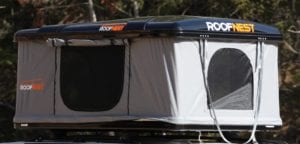
Large doors and windows on the Roofnest
It is great not just for the views, but for the increased airflow as well.
Access is from both sides on a telescopic alu-ladder. The HyBox’s ladder extends up to 8ft 6in which should be enough for all sorts of vehicles.
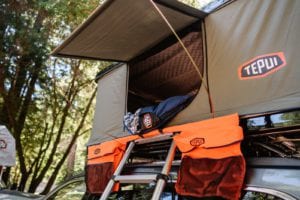
Opening Mechanism
Both roof tents are equipped with gas-charged struts that make opening and folding a really fast and seamless procedure. Both have a metal latch closure system to keep them closed while you travel.
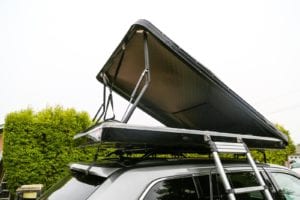
Interiors
As for the useful space inside, the Tepui HyBox has a 51” by 81” sleeping area, and the Roofnest Eagle is roomier with its 54” by 83” size mattress. In terms of headroom both have 37” room height inside.
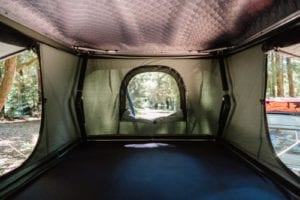
This will not make or break the deal for either of them. On paper, 2 adults and a child can sleep in the Eagle, while the HyBox is recommended for two adults only. If you squeeze them in the Eagle I suppose you can squeeze them in the HyBox too, it will be a remarkable memory for everyone either way…
The HyBox has a slightly thicker mattress (3” vs. 2 ¾”) but the Roofnest Eagle comes with a free anti-condensation mat underneath it.
As I mentioned in my review of the previous Eagle model, there is plenty of storage and stowaway inside the Roofnest Eagle. The new model has an upgraded pocket design, so there is even more space for your belongings in the roof net, the side pockets or you can put your shoes away in a dedicated storage.
The HyBox has a neat little net on the ceiling, but there is not much more space where you can keep your belongings.
Extras
An extra layer of insulation is available for both the Eagle and the HyBox, should you decide to use them in cooler climate.
Apart from this, you can upgrade with an annex, whichever roof tent you buy.
The awning available for the Roofnest Eagle is called the Littlewing. It is 5′ wide where it attaches to the vehicle and 8′ wide at the outer edge when open. The Littlewing Awning down poles are 7′ tall.
The Tepui awning mounts directly to your roof rack or the tracks of the tent and provides the options of: 4’6″ x 6’6″, 6’6″ x 6’6″ or 8′ x 6’6″ area of shade extending from your vehicle. The awning includes 4 poles for height adjustment, guide wires for stability in high wind, and a 1100g PVC travel cover that the awning rolls into for traveling. You can add awning walls and mosquito nets to your awning too.
Warranty
Sadly, Roofnest only provide 1-year warranty on all their products. The Tepui comes with a 2-year warranty on all material, craftsmanship and parts.
Summary
It is really difficult to say which one is better. I honestly think that whichever you buy you get a great product that will bring many happy moments, whether you use it as a roof tent or as a cargo box. There are pros and cons for each, so it depends on how you would like to use your tent.
If you don’t mind leaving it on the top of your car for the whole summer and you would like to use the box to carry things then you would be really happy with your HyBox
Buy the Tepui HyBox on Amazon.com
UK & Europe: the easiest way to order from this Dutch retailer.
If you do want to take it off when not in use you should bear in mind that the Roofnest Eagle is much lighter. You will thank yourself after two or three attempt of taking it off that you picked the one that is 20lbs lighter.
The Roofnest is roomier and have an anti-condensation mat included in the price, have bigger windows and doors. But only comes with a 1-year warranty.
Buy the 2019 Roofnest Eagle from Roofnest US
UK & Europe: Roofnest UK
Tepui HyBox v Roofnest Eagle 2019 Review Summary
| Summary | Tepui HyBox | Roofnest Eagle 2019 |
|---|---|---|
| Exteriors | 3.5 / 5 | 4 / 5 |
| Ease of use | 4 / 5 | 4 / 5 |
| Interiors | 4 / 5 | 5 / 5 |
| Customer Care | 4 / 5 | 3 / 5 |
| Value for Money | 4.5 / 5 | 4.5 / 5 |
| Overall | 4 / 5 | 4.2 / 5 |
| Pros | Cargo capacity, thicker mattress, 2-year warranty | Slim design, light-weight, plenty of pockets, anti-condensation mat, larger windows and doors |
| Cons | Non-removable ceiling, Heavy | 1-year warranty only |
| Where to Buy? | Amazon US | Roofnest US |
Alternatives
Just to mention a few. I start with the most obvious which is the previous Eagle model. It is $350 cheaper even if you buy it with the anti-condensation mat, giving a lot of value for its price.
In terms of cargo capacity it is more common to have racks on top of the hard shell. So while the bedding is stored under the hard case while travelling between two campsites, you don’t lose your cargo capacity.
The Roofnest Sandpiper is one of this kind. It can hold up to 100 lbs on its roof when driving (bikes, skis, kayaks, SUPs, etc) and will sleep two adults comfortably (82″ long x 48″ wide on the inside), same price as the Roofnest Eagle.
See more details on the Sandpiper here
James Baroud Evasion. The Evasion is the same size as the HyBox but has some extra features like thicker fabric, roof fan etc. It has not a removable canopy and it has a hefty price tag though, starting price from $3799.
Maggiolina Airland Plus Medium and Medium XL. Both have the same size double mattress as the Roofnest Eagle however the unit itself is slightly heavier. They have 36” headroom from the mattress to the ceiling which is a bit less and they do not have gas-loaded struts (they open by crank handles). The Airland Plus Medium starts from $2999 + color option; while the XL starts from $3499 + colour option. (Autohome US)
Maggiolina also have a range of hard shell roof tents called Extreme. The Extreme Medium has a 54” wide mattress however it is only 72” long (the whole unit is 83” long, same as the Roofnest Eagle). Starting price is $3699 plus $100 or $200 color option.
If you need a cheaper (and smaller) hard-shell roof tent you might be interested in the rest of the Roofnest family, the Sparrow for example.
Another cheaper alternative is the TentBox. You can read my review on the TentBox here or check out their website here.
You might also be interested in this: Tepui Kukenam Skytent review
I hope you have found this post helpful! Please leave a comment!
Find out if a roof tent would fit your car! Roof load capacity of 200+ makes: Roof Top Tent Weight Limits

